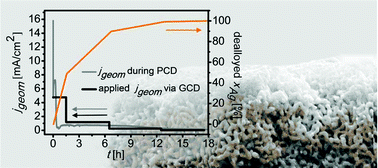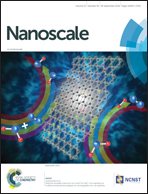Independent control over residual silver content of nanoporous gold by galvanodynamically controlled dealloying†
Abstract
A new procedure was developed and characterized for the galvanodynamically controlled dealloying (GCD) of AuxAg100−x alloys to obtain nanoporous gold (npAu) mainly as an unsupported catalyst material for partial oxidation of alcohols. Such catalysts require residual Ag content of less than 1 at%. GCD was compared to the preparation of npAu by potentiostatically controlled deallyoing (PCD) and free corrosion (FC). The main advantage of GCD is the ability to obtain npAu with a predetermined residual Ag content including residual Ag contents below 1 at% while retarding the coarsening of the ligaments. For PCD and FC, there is a strong increase of ligament size with decreasing residual Ag content because the longer times required for dealloying unavoidably lead to coarsening of the npAu structure. On the other hand, GCD also prevented too high initial current density that leads to cracking of the samples and prevents formation of mechanically stable monoliths. GCD tolerates different compositions of the starting alloy for AuxAg100−x within the tested composition range (20 at% ≤ xAu ≤ 30 at%). The samples obtained by GCD were tested for methanol and ethanol oxidation and showed favorable characteristics for partial oxidation of methanol to methyl formate and of ethanol to ethyl acetate.



 Please wait while we load your content...
Please wait while we load your content...